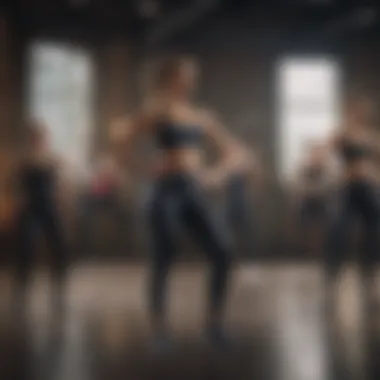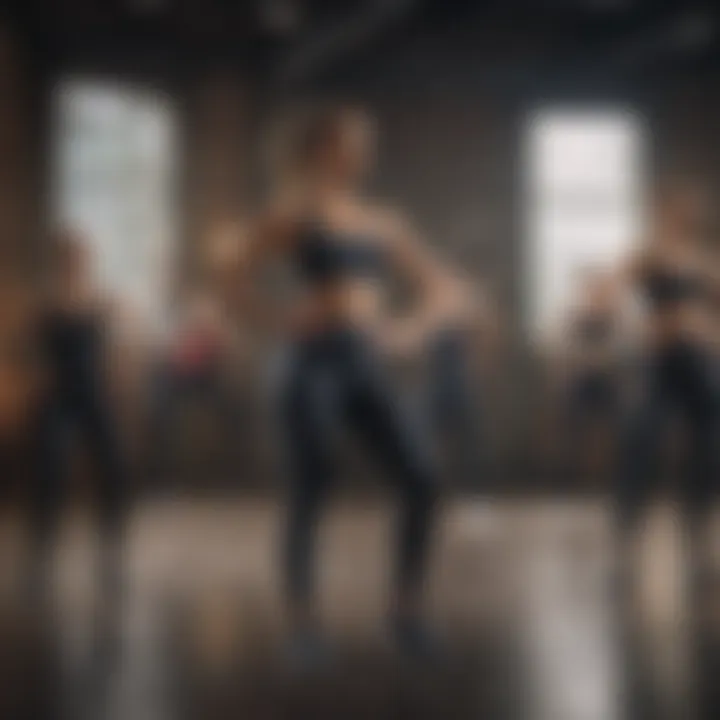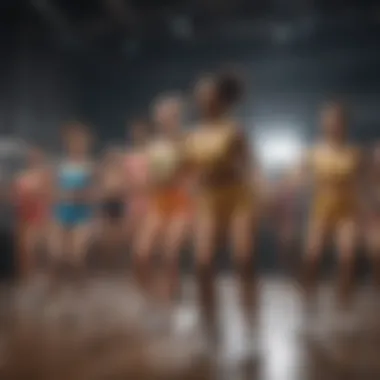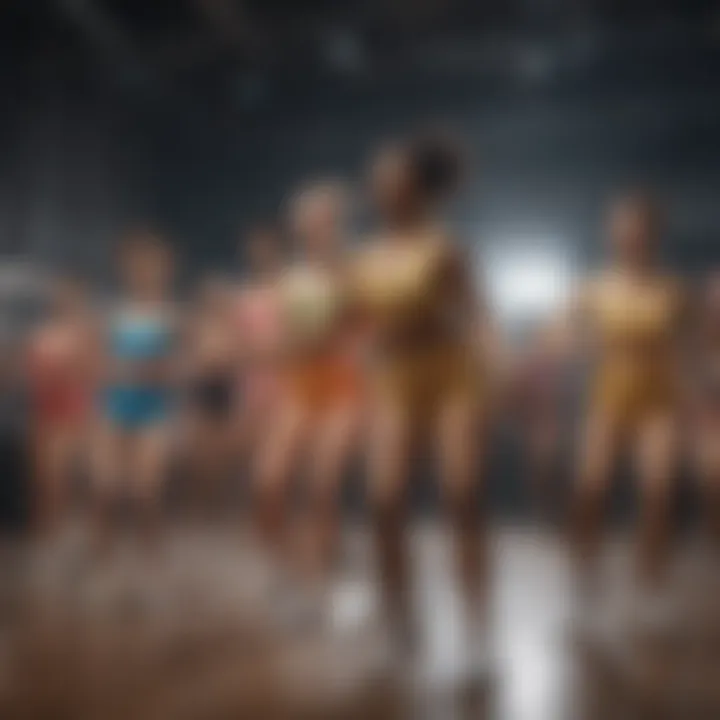Dance Workout Games: Merging Fitness and Rhythm


Intro
There’s something uniquely invigorating about moving to the beat of your favorite song, feeling every rhythm, and letting loose in a way that’s both freeing and energizing. Dance workout games embody this spirit, serving as a bridge connecting physical fitness with vibrant musical engagement. Not only do these games pump up your heart rate, but they also introduce a social aspect that’s hard to resist, allowing players to share their love for movement and music.
In an age where fitness routines can easily become monotonous, dance workout games offer an enticing alternative, combining fundamental exercise with choreography that stimulates both body and mind. As we explore this fusion of fitness and rhythm, we dive into their evolution, appeal, and role in modern wellness regimes.
Evolution of Dance Workout Games
The growth of dance workout games is unmistakably tied to cultural shifts in how we perceive fitness and entertainment. In the early days of gaming, titles like Dance Dance Revolution paved the way for a genre that melded gaming with physical activity. It was not just a game; it was a social phenomenon that encouraged players to gather, compete, and share their love for dance.
As technology progressed, so did the complexity and appeal of these games. Motion sensing technologies, seen in systems like Kinect, amplified the experience by allowing players to become the heroes of their own dance floors without the need for a controller. This evolution reflects a broader trend where fitness becomes intertwined with enjoyment and community.
Cultural Impact
The cultural impact of dance workout games is profound. They challenge traditional views of what fitness looks like, making it accessible and appealing to diverse demographics. The community aspects foster engagement and connect individuals with similar interests.
Many people, regardless of age or background, find joy in expressing themselves through dance, which enhances not only physical health but also mental well-being. Furthermore, these games often expose players to a variety of music genres, promoting a greater appreciation for global rhythms and styles.
Mechanics Behind the Games
Dance workout games are designed to be intuitive and fun. They typically use a combination of choreography, rhythm, and scoring systems to engage players. Here’s how they generally operate:
- Choreography: Players follow on-screen prompts to perform dance moves. The choreography can range from easy to complex, catering to different skill levels.
- Scoring System: Players score points based on their performance, providing motivation and a competitive edge.
- Feedback Mechanism: Many games offer real-time feedback, allowing players to adjust their moves to improve accuracy and timing.
- Customization Options: Modern games often allow players to personalize their avatars and playlists, enhancing the immersive experience.
The combination of these elements creates a workout that feels less like exercise and more like having fun.
Appeal to Diverse Audiences
The allure of dance workout games extends to multifaceted audiences. Here are some reasons why these games draw people in:
- Inclusivity: They welcome individuals of all fitness levels and backgrounds, making fitness accessible.
- Social Interaction: Many games offer multiplayer modes, fostering a sense of community. It’s not uncommon to see friends or family members challenge each other.
- Diverse Music Choices: With genres from pop to hip-hop, players can choose tunes that resonate with them, keeping their workout fresh.
- Flexibility: Players can engage with these games at home or in groups, making it a convenient workout option.
Community Aspects
The community surrounding dance workout games enhances the experience. Online platforms, such as Reddit, provide spaces for players to share their achievements, tips, and routines. Players form friendships and find support through their shared interests in music and dance, creating a sense of belonging in the fitness realm.
The future seems bright for these engaging dance games. As developers incorporate new technologies, such as virtual reality, the gameplay will only get richer and more immersive.
"Dance workout games not only boost your fitness but also ignite a passion for music, creating a harmonious blend that nourishes both body and soul."
Through our examination, we’ve seen that dance workout games are indeed more than just a fun pastime. They represent a fusion of fitness and rhythm that is reshaping how we approach exercise and community engagement alike.
Foreword to Dance Workout Games
Dance workout games have garnered significant attention in recent years, morphing from simple entertainment to powerful tools for fitness. In this article, we will take a close look at these games and unravel their crucial tie to both physical well-being and enjoyment. The blending of dance with workout activities provides a dynamic, engaging way to motivate individuals to stay active, thus presenting noteworthy benefits worth exploring.
Defining Dance Workout Games
At their core, dance workout games are energetic activities that combine choreography and fitness into an interactive experience. Generally intended for a large audience, these games often use popular songs and seek to immerse the gamer in rhythm-based movements. Unlike conventional exercise routines that may feel tedious, dance workouts infused with gaming elements turn fitness into a lively and engaging performance. They often accommodate various styles, from Zumba to hip-hop, reflecting diverse cultures and fostering a rich musical dialogue.
A defining feature is their progression levels, which make them accessible to all ages and skill levels. Gamers, whether novices or seasoned dancers, can find a setup that aligns with their capabilities while pushing their boundaries. Also, the competitiveness introduced by scoring systems keeps participants engaged, prompting them to improve their skills continually.
The Rise of Gamified Fitness
In today’s tech-savvy society, the tendency to gamify routine activities has experienced an uptick, and fitness is no exception. Gamified fitness melds traditional workout methods with game mechanics, creating environments that enhance user engagement. Dance workout games exemplify this trend vividly.
The appeal is evident: they make exercise feel less like a chore and more like an entertaining challenge. This shift came at a time when obesity and sedentary lifestyles became pressing issues. Dance games allow individuals to enjoy a form of physical activity that feels spontaneous and less restricted by conventional rules of exercise.
As fitness enthusiasts or even novices groove along to their favorite tunes, they engage in cardiovascular workouts that raise heart rates and burn calories without the drudgery of the gym. Slowly but surely, dancing transformed into a fun and exciting alternative, reinforcing the notion that fitness can also feel free and enjoyable. The proliferation of such games on various platforms—be it gaming consoles or mobile devices—further enhances their accessibility, inviting more individuals to join in the rhythm of fitness.
Historical Context of Dance and Fitness
The intertwining of dance and fitness spans various cultures and eras, providing a rich foundation for understanding how dance workout games emerged in modern times. This historical context is essential in grasping the significance of dance as a form of physical activity and its evolution into a gamified experience that captivates today’s audiences. Through exploring historical milestones, we can better appreciate the journey that has led to the fusion of fitness and rhythm.
Dance as a Form of Exercise
Historically, dance has not merely been a form of artistic expression but also a vehicle for physical activity. From the traditional folk dances seen in communal gatherings to the energetic movements in carnival celebrations, dance has always played a critical role in physical fitness across cultures. Even before the invention of formal fitness regimens, people danced to celebrate, bond, and express emotions.


Take the example of African tribal dances that incorporate vigorous movements not only to commemorate significant life events but also to maintain cardiovascular health. These communal exercises were rarely framed as fitness in a traditional sense; rather, they were a natural part of daily life, leading to improved agility and strength.
Furthermore, the Latin dance styles, such as Salsa and Tango, provide another prime illustration where movement serves both as an artistic outlet and a robust cardiovascular activity. With rapid footwork and spirited hip movements, participants engage in a workout that feels far from monotonous—encouraging a sense of joy and connection among dancers.
In recent years, the understanding of dance as a legitimate exercise has only gained momentum. Schools and gyms are increasingly integrating dance-based classes into their curriculums. With the lure of rhythm-infused workouts, many are discovering the holistic approach of dance, where fitness is seamless with self-expression.
The Evolution of Fitness Games
The transition of dance into fitness games is a fascinating journey marked by significant technological advancements alongside cultural shifts. Initially, video games were perceived as sedentary entertainment, disconnected from any physical activity. However, as the gaming industry evolved, innovative developers began merging physical movements with gameplay to create engaging and interactive experiences.
One pivotal player in this transformation was Konami’s Dance Dance Revolution released in the late 1990s. This game encouraged users to step in sync with on-screen prompts, not just to play but effectively to perform a workout, leading to a new genre—interactive fitness gaming. Its success sparked a wave of similar fitness games, paving the way for household names such as the Just Dance series and Zumba Fitness.
Gamers of all ages began to discover the fun and enjoyable nature of exercising while dancing. Circumventing traditional gym anxieties, these games made fitness accessible to those who may have previously found conventional workouts unappealing. The rise in popularity highlighted a paradigm shift where physical movement was no longer synonymous with dread but rather became a joyous and communal experience. The trend carried into the modern era, where new technological advancements like virtual reality provide fresh avenues for immersive fitness, ensuring that the dance workout games continuously adapt, innovate, and engage a wider audience.
"The evolution of fitness games has transformed how we perceive exercise, turning a chore into a celebration of movement and rhythm."
Mechanics of Dance Workout Games
The mechanics of dance workout games play a crucial role in shaping the overall user experience and effectiveness of these innovative fitness solutions. Understanding the specific elements involved not only enhances the enjoyment but also underscores the importance of seamlessly integrating movement with rhythm. The goal is to create an environment where players can lose themselves in the music while achieving substantial fitness benefits. This dynamic interplay between gameplay, interaction, and technology forms the backbone of these games, influencing everything from user retention to physical engagement.
Gameplay Mechanics and User Interaction
At the heart of dance workout games lies the gameplay mechanics, which dictate how players engage with the game. Essentially, these mechanics can be split into different frameworks based on user interaction. Movement accuracy and timing are paramount; players must mirror on-screen avatars to score points. This can lead to a highly immersive experience, where individuals are not merely observing but actively participating.
The various modes of play often cater to different skill levels and preferences. A beginner might enjoy simpler dance routines, while advanced players can tackle complex choreography. Furthermore, levels of difficulty can change seamlessly as one progresses, ensuring that players remain challenged yet motivated.
Interaction also plays a key role in community building. Players can connect with friends through competitive challenges, fostering a sense of camaraderie. This not only drives engagement but enhances the fun factor, as participants get to share accomplishments and progress. In essence, the gameplay mechanics are designed to ensure that fitness doesn’t feel like a chore; it becomes a source of joy.
"The best fitness games are those that make you beg for more, where the workout sneaks up on you amidst hours of playful dance."
Technology and Motion Detection
The advancements in technology have propelled dance workout games into a league of their own. Motion detection technology is a critical aspect, translating the player's movements into the game interface. This technology often relies on cameras and sensors to track the player’s body movements in real-time.
Systems like Kinect or devices with integrated motion sensors create a feedback loop that evaluates performance almost instantaneously. Players receive feedback based on their movements—eg. whether they have hit a target or matched the tempo. This provides a sense of accomplishment as participants see their progress reflected on-screen, motivating them to achieve higher scores.
Moreover, with the rise in popularity of virtual reality, future dance workout games are booming with potential. Imagine being immersed in a vibrant, animated environment where every move is detected, and the music pulsates around you. This kind of integration not only elevates the sensory experience but also adds an exciting layer to fitness, making exercise feel less like a task and more like an adventure.
Cultural Influence of Dance Workout Games
The intertwining of dance and fitness through gaming transcends mere entertainment; it reflects a broader cultural phenomenon. Dance workout games have become a cultural artifact, revealing trends, habits, and community engagement patterns that are prevalent in today's society. As people immerse themselves in these experiences, they connect not only with the game but also with the diverse music and dance styles that define their identities.
Representation of Music and Dance Styles
Dance workout games offer players a vivid collage of musical genres and dance styles, serving both as a history lesson and a cultural showcase. In titles like Just Dance, players might find themselves shimmying to everything from classic rock to recent pop hits, introducing them to artists and songs they may not have encountered otherwise. This aspect goes beyond just gameplay; it cultivates an appreciation for varied musical traditions.
Through these games, dance styles like salsa, hip-hop, and Bollywood are portrayed, giving players a taste of global cultures. This representation is crucial for fostering an inclusive atmosphere. Players might not simply enjoy moving to the beats; they also learn the story behind the dances that accompany the music. For example, experiencing the vibrant energy of Zumba allows individuals to appreciate Latin dance heritage while engaging in a full-bodied workout.
Moreover, the integration of diverse dance styles encourages appreciation for cultural nuances. Each routine encompasses not only the physical movements but the essence of each style, whether it be the fluidity of contemporary dance or the sharp rhythms in breakdancing. This array of choices attracts a broad spectrum of players, leading to a melting pot of cultural exchange.
Global Popularity and Trends
The global reach of dance workout games is nothing short of impressive. From Tokyo to New York, these games have tapped into a universal love for music and movement. Today, millions of players are engaged, reflecting various trends that shape their countries' social and cultural landscapes.
With the help of online platforms and streaming services, trends spread faster than wildfire. Popular dance challenges on social media often drive a surge in game sales or downloads. A TikTok sensation can bring back older tracks and reintroduce them to a new generation, thereby reinvigorating interest in the game that features those tracks. Customs like this enhance the visibility of dance workout games beyond traditional marketing avenues.
The COVID-19 pandemic acted as a significant catalyst for change in how these games are perceived. With gyms and fitness studios closing, many turned to their living rooms for exercise, leading to a boom in downloads. People craved not just fitness but connection—a sentiment that these games provided through multiplayer modes. Players from different parts of the world could groove together, fostering a sense of community despite physical distances.
As attention continues to grow, so does the complexity of music rightsholder agreements, further enriching the diverse offerings available. This evolution hints at the bright future for dance workout games, as music and dance can consistently adapt to reflect changing cultural landscapes. In essence, these games are more than just fitness tools; they're cultural bridges connecting players through rhythm, movement, and shared experiences.
"Dance workout games have emerged as more than fitness routines; they embody cultural expressions and foster global connections."
In summary, the cultural influence of dance workout games cannot be overstated. They represent a dynamic junction where fitness, music, and community converge, providing players with a uniquely engaging way to stay active while honoring diverse musical traditions.
Benefits of Dance Workout Games
Dance workout games serve as a dynamic fusion of fitness and rhythm, offering a multitude of advantages that extend beyond mere physical exercise. As society increasingly gravitates towards interactive forms of fitness, understanding these benefits becomes vital for those exploring their role in achieving well-being. They promise not just the joy of movement, but also a richer engagement with one’s body and an improved sense of community.


Physical Health and Fitness
Engaging with dance workout games can dramatically enhance physical health. When we think about fitness, many people envision sessions at the gym or jogging down the street. However, dance workouts present a fun alternative where individuals can get their hearts racing without feeling like they are slogging through traditional exercises. While mastering moves to iconic tracks, players can burn significant calories, often in ways that feel more like play than work.
- Cardiovascular Improvements: The rhythmic nature of dance promotes better heart health. Activities that elevate the heart rate can reduce risks related to heart disease.
- Muscle Strength and Endurance: Different dance styles target various muscle groups. For instance, hip-hop might focus on core strength, while salsa enhances lower body fitness.
- Flexibility and Coordination: Regular participation in these games can improve overall flexibility and coordination. As players navigate complex rhythms and footwork, they inadvertently develop their motor skills.
"Engaging in dance is not just about moving to the beat; it's about feeling alive while doing so."
Moreover, players often find themselves more motivated to pursue regular activity when it feels natural and enjoyable. It becomes less about meeting a quota of reps or miles, and more about having a spirited time. When every session is a different challenge fueled by popular music, it can create a lasting commitment to health that many traditional workout regimens lack.
Mental Well-being and Community Building
The mental benefits that accompany dance workout games, while less tangible, are equally important. In an increasingly digital world, the opportunity for social interaction can sometimes dwindle. However, these games promote a sense of community, gathering friends and family, and even allowing online global interactions.
- Stress Relief: Dance is a natural stress buster. It encourages the release of endorphins, which can elevate mood instantaneously. Whether it’s a solo game on a rainy day or a communal session, dancing puts a spring in one’s step that lasts long after the game ends.
- Building Connections: Engaging in games like Just Dance or Dance Dance Revolution can also create bonds. Collaboration in competitions or sharing results on platforms can evoke a sense of belonging.
- Boosting Confidence: Mastering difficult choreography or achieving high scores can foster a sense of accomplishment. This confidence can spill into other areas of life, prompting individuals to embrace challenges more readily.
Ultimately, the experiences derived from dance workout games pivot around building a supportive network. Friends might gather for a dance-off, or online forums might thrive with motivational discussions, reinforcing the bonds formed through movement.
In essence, the benefits of these games, ranging from improved physical fitness to enhanced mental well-being, showcase why they stand as a pivotal option for those seeking holistic health. Every sway, every beat becomes part of a larger narrative that not only enhances individual lives but knits a broader community together.
Popular Dance Workout Games Reviewed
In the realm of dance workout games, a small selection of titles has managed to leave a big footprint in both the gaming and fitness communities. These games not only provide an entertaining avenue for exercise but also foster a sense of community among their players. Each game brings unique mechanics and appeals, ensuring that there is something for everyone, regardless of skill level or preference. This section sheds light on popular dance workout games, highlighting their relevance and the specific elements that make them stand out in the fast-evolving fitness landscape.
Just Dance Series
The Just Dance series, launched by Ubisoft in 2009, has arguably set the gold standard for dance workout games. With its catchy selection of songs covering a broad spectrum of genres, the series appeals to audiences of all ages. It’s designed to let players mirror on-screen choreography, promoting both physical activity and musical enjoyment. Each iteration introduces fresh tracks, ensuring players always find something new.
Key Elements of Just Dance:
- Accessibility: The game is available on various platforms, from consoles to mobile devices, making it easy for many to jump in.
- Variety: With thousands of songs available, there’s a choice to match any taste.
- Multiplayer Options: Players can dance alone or with friends, increasing the fun and forming social connections.
"The Just Dance series has made dance accessible to millions, blending fitness and fun seamlessly."
Players frequently share their achievements online, encouraging a communal spirit that enhances the engagement. This aspect is vital, as it transforms the workout from a solitary endeavor into a shared experience.
Dance Dance Revolution
The Dance Dance Revolution (DDR) franchise pioneered the rhythm game scene with its innovative use of a dance pad, released initially in 1998. Unlike traditional dance games, DDR requires players to step on directional arrows in time with music. The physical engagement and the sheer energy levels demanded by the game are undeniable, making it one of the best-calibrated workouts available.
Why DDR Matters:
- Cardiovascular Exercise: With its fast-paced gameplay, DDR is an excellent option for those seeking a substantial cardio session.
- Strategic Gameplay: Players must focus not only on dance movements but also on timing and rhythm, offering an engaging mental challenge as well.
- Community Events: Many arcades host tournaments, which helps foster community among enthusiasts.
The DDR culture has transcended mere entertainment, building a passionate following that regularly meets for dance-offs, contributing to both skill enhancement and community building.
Zumba Fitness
Zumba Fitness bridges the gap between dance party and workout, emphasizing Latin-inspired music and dance moves. Launched by Zumba Fitness LLC in the early 2000s, the game captures the essence of what Zumba represents—a fun, energetic, and effective workout. Players can follow along to choreography set to upbeat tracks, making exercise feel less like a chore and more like a celebration.
Highlights of Zumba Fitness:
- Cultural Diversity: The game includes various dance styles from around the globe, connecting players through universal rhythms.
- Customization: Players can tailor their routines based on skill levels or specific dance styles they prefer.
- Motivational Elements: The upbeat atmosphere encourages engagement, often leading to social interactions among players.
Through innovative features and a welcoming vibe, Zumba Fitness remains a preferred choice for those looking to dance their way to fitness, making it a spirited community where friendships flourish.
In summary, the dance workout games highlighted here—Just Dance series, Dance Dance Revolution, and Zumba Fitness—each demonstrate distinctly different approaches to merging physical activity with fun. They emphasize accessibility, social interaction, and the sheer joy of music and movement, attracting diverse audiences. As the gaming landscape evolves, these titles exemplify how dance workout games can enrich physical activity, foster communities, and shape modern fitness culture.
Future Trends in Dance Workout Games
The ever-changing landscape of fitness and entertainment makes it clear that dance workout games are not an ephemeral trend; rather, they are evolving. As technology leaps ahead, the integration of new platforms and innovative interfaces becomes essential in keeping both engagement and fitness at the forefront of these games. Understanding these shifts is important for enthusiasts wanting to make the most of their dance experiences. Here, we’ll take a closer look at the specific advancements expected to shape the future of dance workout games.
Integration of Virtual Reality
Virtual reality (VR) is increasingly transforming the way we interact with games, offering immersive experiences that traditional formats cannot match. Dance workout games utilizing VR will allow players to step into entirely different environments. Imagine dancing in a vibrant club or on a picturesque beach right from your living room! This liberation from the physical confines of a room enhances motivation and makes workouts feel less like a chore and more like an adventure.
Moreover, VR can facilitate real-time feedback from the system. Through advanced motion tracking, users are informed about their performance with astonishing accuracy. Such insights can encourage adherence to correct postures and movements, thus reducing injury risk. Currently, games like Beat Saber have already begun utilizing aspects of VR to create engaging and physically demanding gameplay. As this technology develops, it's reasonable to predict that more comprehensive dance games will emerge, enabling players to feel fully immersed within the rhythm.


Emerging Platforms and Technologies
The rise of smart devices is paving the way for diversity in how dance workout games are delivered and experienced. Devices like smartphones and tablets are already being exploited for these games, but there is potential for much more. The future may see more advanced wearable technology, enabling further interaction and personalization during workouts. Imagine a wearable that not only tracks your heart rate but adjusts the game difficulty automatically based on your exertion level!
Similarly, cloud gaming technologies will allow users to access high-quality games on various devices without the need for specific hardware. This opens the door for conversation, competition, and camaraderie among players globally, regardless of their individual circumstances or capabilities.
In addition, integrating AI into these games can create tailored experiences for users based on their preferences and performance histories. Such advancements might even introduce various skill levels within a single game, fostering both competition and collaboration among players.
"The evolution of dance workout games reflects not just technological advancements but also a deeper understanding of user engagement and fitness dynamics."
Ultimately, as these technologies and platforms progress, dance workout games will likely become more adaptable and intuitive, allowing for a wider user base and broader appeal. Music enthusiasts and aspiring dancers are bound to benefit from these changes, making fitness not just another task on their checklist, but a joyful part of their everyday lives.
The Role of Community in Dance Workout Games
Dance workout games aren't just about the choreography or the rhythm; they blossom into a shared experience when the community steps in. The significance of these collective interactions creates bonds that transcend mere physical activity. For many, it’s not just about getting more active but becoming part of a tribe that shares similar passions for music and movement.
Communal aspects of these games can lead to significant benefits. Participants become motivated by others, often pushing each other to step outside their comfort zones and achieve new fitness milestones. The camaraderie that develops through shared struggles and triumphs often transforms the way individuals approach fitness.
Online Competitions and Social Interaction
Engaging in online competitions is like stepping onto a digital dance floor where all participants showcase their skills while being cheered on by a global audience. This virtual context allows for exciting social interaction, creating a hodgepodge of backgrounds, cultures, and dance styles.
- Dynamic Platforms: Many dance game platforms, such as Just Dance and Dance Dance Revolution, offer leaderboards where users can compete against friends or players worldwide. The rush of competing can empower individuals to practice more, as they aim to improve their score or performance.
- Challenges and Tournaments: Weekly challenges or tournaments serve as a hook for players, inspiring them to log on and participate. This not only enhances their skills but also cultivates a community that thrives on fun and friendly competition.
- Interactive Features: Social media integration allows users to share their victories and experiences on platforms like Facebook and Reddit, further strengthening connections. Players often comment, encourage, or even provide tips to one another, fostering a sense of belonging.
Engagement in online dance competitions can lead to accountability and support when friends or teammates cheer each other on during chilly competition nights.
Supportive Networks and Groups
Supportive networks and groups form the backbone of dance workout games. Whether through local meet-ups or virtual communities, these groups provide invaluable support. The diversity of members—ranging from beginners to seasoned dancers—creates a nurturing environment that encourages learning.
- Local Meet-ups: Many enthusiasts organize local gatherings to dance together. These events can be informal, where the emphasis lies more on fun rather than perfection, or structured training sessions aimed at hone skills.
- Online Forums: Platforms like Reddit harbor communities where players share advice, routines, and personal stories, allowing others to relate and learn vicariously. Such forums often serve as idea pools, where members can pick up fresh moves or workout tips.
- Social Media Groups: Facebook groups dedicated to specific games foster discussion about challenges, releases, and experiences. These connections can blossom into lasting friendships, driven by shared goals and passion for dance.
Ultimately, the collective experience makes dance workout games more than just a solitary endeavor. They evolve into a space where individuals find joy, support, and motivation, accentuating the very essence of communal spirit.
Challenges in Dance Workout Gaming
The realm of dance workout games, with all its vibrant energy and rhythmic beats, isn't without its hurdles. Understanding the challenges faced within this genre is essential for enhancing user experience and maximizing engagement. It’s not just about having fun while breaking a sweat; the underlying issues influence access, participation, and, ultimately, the overall effectiveness of these fitness tools.
Accessibility Issues
Accessibility can make or break the experience in dance workout games. Not everyone has the same level of physical ability or access to technology. Some games require specific hardware, like motion sensors or dance mats, which might not be widely available or affordable for all. This can create a significant barrier for those who wish to join in the fun. Not to mention, some workout routines in these games may be too intense for beginners or individuals with certain physical limitations. It's vital for developers to consider adaptive features or adjustable difficulty settings that cater to varied skill levels.
In many ways, inclusivity could be the name of the game. If someone feels left out due to a lack of suitable options, they won’t benefit from what these games have to offer. Companies like Just Dance have made strides with some versions, including modes tailored for young children and older players, allowing wider audiences to groove along.
"When accessibility is prioritized, dancing becomes an open invitation rather than an exclusive club."
Balancing Fun with Fitness
The fine line between pure enjoyment and actual fitness can often become blurred in dance workout games. While the catchy tunes and lively graphics create an inviting atmosphere, it might lead to the misconception that they are just games—rather than well-structured workouts. Some users might treat them as mere entertainment rather than an avenue for physical health, which reduces potential benefits.
In an ideal world, these games should provide an engaging experience while keeping players physically challenged. Developers face the task of structuring their gameplay to promote exercise without sacrificing fun. For example, incorporating challenge modes that push players to surpass their previous scores—but still maintain that playful essence—could retain the gamified joy while heightening fitness levels.
Players also need reminders of the fitness elements involved. Visual cues, like progress tracking or performance feedback, can keep participants focused on their workout goals, ensuring they aren't just dancing but genuinely working out.
Navigating these challenges is essential for creating a more rewarding and effective experience in dance workout gaming, engaging everyone in the joy of movement and rhythm.
Epilogue
The conclusion serves to weave together all the threads of a detailed discussion about dance workout games. It’s not just a summary; it highlights the significance these games hold in today’s fitness landscape. Dance workout games provide an innovative blend of movement and music, allowing users to immerse themselves in physical activity while enjoying a diverse range of music genres. This dual focus on both fitness and enjoyment is crucial in motivating individuals who might otherwise find traditional workouts monotonous or unappealing.
Revisiting Key Insights
As we reflect on the previous sections, it becomes clear that dance workout games have evolved from simple forms of entertainment into a vital component of a modern fitness regime. They cater to various demographics, making fitness accessible to diverse audiences. This accessibility is largely attributed to advancements in technology, such as motion detection and adaptive difficulty levels, that make these games enjoyable for both beginners and seasoned dancers. Furthermore, the cultural richness these games offer—integrating different dance styles and music genres—enhances their appeal, making them a unique tool for cultural expression and physical fitness.
“Incorporating movement with enjoyment leads to sustained engagement and improved well-being,” says a prominent fitness researcher.
Future Prospects in Dance and Fitness Integration
Looking ahead, the future of dance workout games seems promising with technological innovations on the horizon. The integration of virtual reality stands to elevate the gaming experience, creating immersive environments where users can dance in settings ranging from vibrant dance halls to serene beach fronts. These advancements not only enhance user engagement but also have the potential to provide a more comprehensive workout experience.
Moreover, as fitness continues to gravitate towards online platforms due to increased digital connectivity, community features will likely expand. Interactive competitions and collaborative challenges will serve to bring people together, fostering not just fitness, but also relationships built on shared goals and interests.
In essence, the integration of technology with artistic expression through dance is shaping the future of fitness. As more users rediscover the joy of movement, the importance of community and engagement will continue to thrive, ensuring that dance workout games remain relevant and instrumental in promoting a healthier lifestyle.





